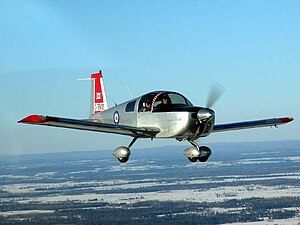
The de Havilland Canada DHC-1 Chipmunk is a tandem, two-seat, single-engined primary trainer aircraft designed and developed by Canadian aircraft manufacturer de Havilland Canada. It was developed shortly after the Second World War and sold in large numbers during the immediate post-war years, being typically employed as a replacement for the de Havilland Tiger Moth biplane.

The Pitts Special is a series of light aerobatic biplanes designed by Curtis Pitts. It has accumulated many competition wins since its first flight in 1944. The Pitts biplanes dominated world aerobatic competition in the 1960s and 1970s and, even today, remain potent competition aircraft in the lower categories.

The T-211 is a light aircraft designed in the US by John Thorp in 1945. It is a low-wing monoplane of conventional layout with a fixed tricycle undercarriage and a sliding canopy. John Thorp developed the Sky Scooter with lessons learned from developing the Lockheed Little Dipper project in 1944. It bears some family resemblance to the Piper Cherokee, a design that Thorp later significantly contributed to.

The Piper PA-38-112 Tomahawk is a two-seat, fixed tricycle gear general aviation airplane, originally designed for flight training, touring and personal use.

The Bede BD-5 Micro is a series of small, single-seat homebuilt aircraft created in the late 1960s by US aircraft designer Jim Bede and introduced to the market primarily in kit form by the now-defunct Bede Aircraft Corporation in the early 1970s.

The Grumman OV-1 Mohawk is an American armed military observation and attack aircraft that was designed for battlefield surveillance and light strike capabilities. It has a twin turboprop configuration, and carries two crew members in side-by-side seating. The Mohawk was intended to operate from short, unimproved runways in support of United States Army maneuver forces.

The Beechcraft Model 77 Skipper is a two-seat, fixed tricycle gear general aviation airplane, originally designed for flight training but also used for touring and personal flying.

American Aviation Corporation was an American aircraft manufacturer based in Cleveland, Ohio, in the 1960s, which produced light single-engine aircraft. In 1972, it became the Grumman American Aviation Corporation.
The Bede BD-1 was a two-seat, single-engine, low-wing monoplane, the first design of American aeronautical engineer Jim Bede. The BD-1 was designed in 1960 as a kit-built aircraft intended for home assembly by amateur builders. Design goals included a kit price of $US 2500, including a rebuilt 100 hp (75 kW) engine and a cruise speed of 130 knots (240 km/h). The prototype N624BD first flew in 1962.

The Grumman American AA-5 series is a family of American all-metal, four-seat, light aircraft used for touring and training. The line includes the original American Aviation AA-5 Traveler, the Grumman American AA-5 Traveler, AA-5A Cheetah, and AA-5B Tiger, the Gulfstream American AA-5A Cheetah and AA-5B Tiger, the American General AG-5B Tiger, and the Tiger Aircraft AG-5B Tiger.
The American Aviation AA-2 Patriot was a four-seat, all-metal aircraft that was developed in 1970-71 by American Aviation of Cleveland, Ohio. The design did not progress beyond the prototype stage.

The Gulfstream American GA-7 Cougar is an American all-metal, 4-seat, twin-engined light aircraft. The Cougar was a twin-engine development of the Gulfstream American AA-5B Tiger and traces its lineage to the AA-1 Yankee Clipper and the Bede BD-1.

The Lycoming O-360 is a family of four-cylinder, direct-drive, horizontally opposed, air-cooled, piston aircraft engines. Engines in the O-360 series produce between 145 and 225 hp, with the basic O-360 producing 180 hp (130 kW).

James R. Bede was an American aircraft designer and developer, particularly noted for his development of influential, fast, efficient, light aircraft, including his BD-1, and the BD-4, BD-5 and BD-10 kitplanes. He designed well over a dozen aircraft starting in the 1960s, but a string of business failures, and legal, technical and safety problems kept most of these designs out of widespread use.

The Aviat Husky is a tandem two-seat, high-wing, utility light aircraft built by Aviat Aircraft of Afton, Wyoming.

The Alpha Aviation Alpha 2000 is a two-seat, all-metal training and general aviation aircraft, designed by Chris Heintz and built in Hamilton, New Zealand. It continues the successful French Apex Aircraft's Robin R2000 series acquired upon Apex's purchase of the Avions Robin company.

The Bede BD-4 is an American light aircraft, designed by Jim Bede for homebuilding and available since 1968. It was one of the first homebuilt aircraft to be offered in kit form. It remains one of the world's most popular homebuilts with thousands of plans sold and hundreds of examples completed to date.

The Rockwell Commander 112 is an American four-seat single-engined general aviation aircraft designed and built by North American Rockwell starting in 1972. In 1976, they introduced the turbocharged version 112TC and mounting a larger engine with other minor improvements they introduced the Rockwell Commander 114. A total of approximately 1,300 examples of all models were produced before the production line shut down in 1980. In 1981, the type certificate owner was Gulfstream Aerospace, but that company had no interest in single-engine piston production.

The Kestrel KL-1 is an American single-engined four-seat utility aircraft designed and built in the 1990s by the Kestrel Aircraft Company of Norman, Oklahoma.

The Bede BD-12 was an American homebuilt aircraft designed by Jim Bede and produced by Bede Aircraft of Medina, Ohio, introduced in the 1990s. The aircraft was intended to be supplied as a kit for amateur construction, but only one was ever built. It first flew in 1995.
























